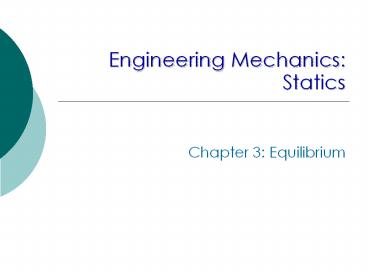Engineering Mechanics: Statics - PowerPoint PPT Presentation
Title:
Engineering Mechanics: Statics
Description:
Engineering Mechanics: Statics Chapter 3: Equilibrium Equilibrium Part A: Equilibrium in Two Dimensions Equilibrium In equilibrium, Before applying the equation, we ... – PowerPoint PPT presentation
Number of Views:586
Avg rating:3.0/5.0
Title: Engineering Mechanics: Statics
1
Engineering Mechanics Statics
- Chapter 3 Equilibrium
2
Equilibrium
Part A Equilibrium in Two Dimensions
3
Equilibrium
- In equilibrium,
- Before applying the equation, we must define the
mechanical system to be analyzed and represent
all forces acting on the body - To do that, the body has to be isolated from all
surrounding bodies - A diagramatic representation of the isolated
system treated as a single body free-body
diagram (FBD)
4
Free-Body Diagram
5
Free-Body Diagram
6
Free-Body Diagram
7
Free-Body Diagram
8
Free-Body Diagram
9
Free-Body Diagram
10
Equilibrium Conditions
- In two dimensions, equations of equilibrium may
be written as
11
Two- and Three-Force Members
- A body under the action of two forces only
two-force member - For a two-force member to be in equilibrium, the
forces must be equal, opposite and collinear - For a three-force member, equilibrium requires
the lines of action of the three forces to be
concurrent
12
Sample Problem 3/4
Determine the magnitude T of the tension in
the supporting cable and the magnitude of the
force on the pin at A for the jib crane shown.
The beam AB is a standard 0.5-m I-Beam with a
mass of 95 kg per meter of length.
13
Problem 3/24
A block placed under the head of the claw
hammer as shown greatly facilitates the
extraction of the nail. If a 200-N pull on the
handle is required to pull the nail, calculate
the tension T in the nail.
14
Problem 3/48
The small crane is mounted on one side of
the bed of a pickup truck. For the position q
40º, determine the magnitude of the force
supported by the pin at O and the force p against
the hydraulic cylinder BC.
15
Equilibrium
Part A Equilibrium in Three Dimensions
16
Equilibrium Conditions
- In three dimensions, equations of equilibrium may
be written as - Statical determinacy
- The supporting constraints are not more than the
number required to establish equilibrium
condition - If the supports are redundant, the body is
statically indeterminate
17
Free-Body Diagram
18
Free-Body Diagram
19
Sample Problem 3/5
The uniform 7-m steel shaft has a mass of
200 kg and is supported by a ball-and-socket
joint at A in the horizontal floor. The ball end
B rests against the smooth vertical walls as
shown. Compute the forces exerted by the walls
and the floor on the ends of the shaft.
20
Problem 3/67
The light right-angle boom which supports
the 400-kg cylinder is supported by three cables
and a ball-and-socket joint at O attached to the
vertical x-y surface. Determine the reactions at
O and the cable tensions.































